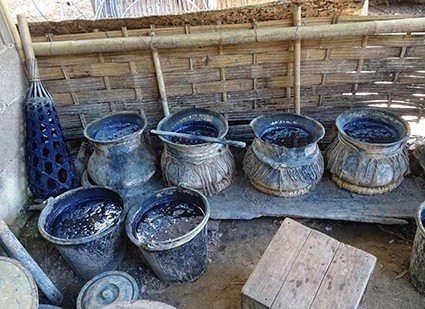Across Asia, traditional textiles testify to people’s ingenuity for transforming plants into products of great significance and beauty, literally weaving together nature and culture. Making this link between nature and culture, the Pha Tad Ke (PTK) Botanical Garden has a great living collection of plants used as sources of natural dyes and fibres that is well worth seeing. This is a very appropriate theme for PTK, given the fame of Luang Prabang province’s Tai Lue weavers.
Traditional textiles skilfully integrate many things: local knowledge of plant chemistry, strength of cotton or silk fibres, and incredible skill and mathematical precision to produce specific motifs that reflect cultural identity and religious beliefs.
Understanding the cultural context of plant use for textiles is crucial, particularly for those admiring textiles from the Lao PDR in museums, galleries and private collections far away from the homesteads and cultural landscapes where they were produced.
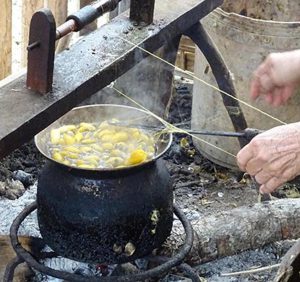
Tradition silk production
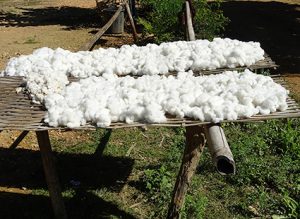
Cotton drying in the sun
Across the cultural and botanical diversity of the Lao PDR, dyers use a great diversity of natural dyes and mordant species to produce textiles. Indigo, for example, is a remarkable vat dye, with the best-known sources of indigo (Indigofera tinctoria and I. suffruticosa) both used by many cultural groups in Luang Prabang province. Indigo dyed threads, when combined with tannins, can also produce a dark black. Black colours in Tai Lue textiles are often a result of over-dyeing indigo threads with tannin rich tubers, such as those from the wild yam, Dioscorea cirrhosa and bark or leaves from several tree species. These form a substantive and colour-fast dye.
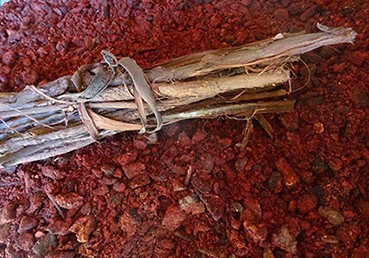
Indigo is typically produced through a process that starts with roughly chopped or torn Indigofera leaves, with a change from a water-soluble form in alkaline ash water, through oxidization into a water-insoluble pigment that is colour-fast and washable. Use of alkaline water from ash, or, in the limestone (karst) landscapes of the Annamite mountain range, lime from burnt limestone mixed with water, is an important part of the process. This conversion process and the change from a green colour to the blue-purple indigo with oxidization is something magical to anyone seeing this happen. And it is, quite literally, a magical process to many Tai Lue weavers, who silently make a prayer to the spirit (phi) of the dye pot during this process, wishing for perfect deep indigo colour.
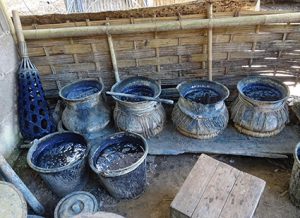
Dye pots and stirring basket in the Nambak area, Lao PDR
- Specific plant species are also important for making weaving equipment, such as bamboo baskets for stirring indigo dye pots. The looms and spindles are made from high-density hardwoods (such as Pterocarpus indicus).
Weavers want to avoid breaking threads during weaving. Warp threads are under particularly high tension during the weaving process and both warp and weft threads are subject to abrasion, so the threads have to be strong and abrasion resistant. In Laos, black wax from giant honey bee combs (Apis dorsata, Apidae) is used to reduce abrasion by waxing weaving swords.
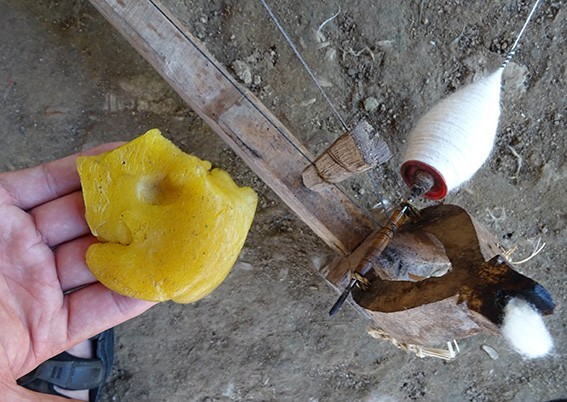
Wax from giant honey bees being used in cotton spinning, Lao PDR
Each textile is a unique combination of plants as dyes, astringent ashes, oils, enzymes and mordants that create a woven connection that communicates cultural identity. The diversity of weaving styles and the plant species used is very rich in the Indochina region. Just as the cross-border area of Laos, SW China and Vietnam is a cultural and biodiversity “hot-spot”, so it is a “hot-spot” of diversity for the plant species that can be used for indigo, beyond just Indigofera. In this region, for example, Marsdenia and Strobilanthes cusia (Acanthaceae), Polygonum (Polygonaceae) and several Wrightia species (Asclepiadaceae) have been used as indigo sources in the past.
Yet textile production is immensely vulnerable to change. The principle issues affecting the survival of high quality traditional textile production are the transmission of dye knowledge, the continued availability of some wild dye plant resources, and the economics of weaving. These three issues are closely interrelated. The processes of hand-spinning cotton, natural dyeing or producing silk at a village level are all time consuming. The same is true of production of fine quality textiles. So the temptation to weave cheap handbags or scarves for the night-market in Luang Prabang or weave curtains on order for entrepreneurs in Thailand is very understandable. Weaving materials are too easily replaced by synthetic dyes, imported silk from China or Vietnam or motifs imposed by western designers. Even the plants themselves are being depleted and lost as vast areas of northern Laos and south-west China have been converted to monocultures of banana or rubber plantations.
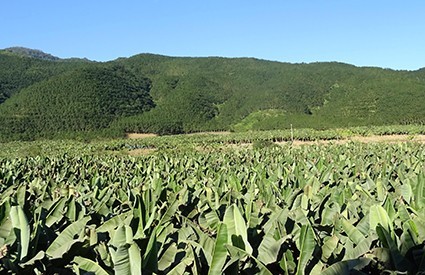
Rubber plantations and banana monocultures are transforming the landscapes of the cross-border areas of Yunnan, China and northern Laos.
Loss of knowledge about traditional textile plants is about much more than the production process, however. It is also about the vitality of language and vocabulary in the many local languages of the Lao PDR. Being able to correctly name plant species and varieties, the places where they occur and to collect and use them is an essential part of knowledge transfer. So is the naming of the entire material culture of textile production, such as the specific name for the baskets used by dyers to oxygenate indigo dye pots. Or the names for specific colours, of ingredients or the steps in complex applied chemical processes. Loss of language, or loss of respect for an older generation who are keepers of these oral traditions and knowledge, undermines cultural resilience. PTK, through its living plant collection, backed up by solid ethno-botanical studies, can be a record of that library of knowledge and a way of building resilience and keeping the “culture-nature” thread strong.
This guest blog was written by Dr A. B (Tony) Cunningham, and all text and photographs are copyrighted to him.
Dr A. B (Tony) Cunningham is an ethnobotanist and graphic artist (www.tonysartandnature.com) who has worked with dyers of baskets and textiles in Africa and Asia over the past 37 years. He was the Society for Economic Botany’s 2016 Distinguished Economic Botanist. He has worked with Threads of Life (www.threadsoflife.com) in Indonesia for 15 years and visited Laos and PTK while on holiday in October 2016.



